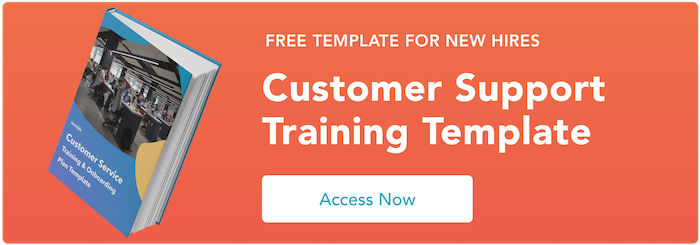Team members will move on, others will get promoted, and new people will want to join your team. We all understand these dynamics, but we're rarely deliberate about managing these scenarios to help build predictability into your customer support team hiring model.We’ll cover common customer success career paths, how to scale your team and what qualities make for ideal customer success candidates.
Creating A Customer Success Career Path Within Your Organization
Career paths might sound simple, but getting them right is tricky. Many other customer success professionals I know can dismiss the exercise of career pathing as a luxury. I might agree with that in the case of a fast-growing startup, or a brand-new customer success team making its first few hires. However, once you start scaling your customer success team, it's necessary to spend time on this.
It's useful to think about career paths in customer success organizations from three perspectives:
- How to feed into your customer success team with people from other departments within in your company
- How to retain and grow your existing team members
- How to feed the rest of the company with talent nurtured from within your team
It's not just about how you craft career paths within your team -- it's also about how people flow in and out.
It's difficult to tackle all of these challenges at once, so I would prioritize your starting point by asking some questions about your team:
- How long does it take to fill an open CS role? Does it take too long?
- Are we struggling to hire external candidates at the right level?
- What's our attrition rate on the team?
- What's our average tenure on the team?
- What's the average ramp time on the team?
- When people leave where do they go and for what reasons?
- What is the feedback from the team on career growth?
It may take a while to get the answers to those questions, but it should shed some light on where the priority is. For example, if you have a happy team that's getting promoted and sticking around, but struggle to fill new roles in a timely manner, it makes sense to spend a disproportionate amount of time thinking of career paths to feed your team from other departments.
Is customer success a good career?
If you enjoy being client-facing and are looking for a field with high growth potential, customer success can be a rewarding career. In fact, LinkedIn ranked customer success as one of the fastest growing fields back in 2020 and its momentum has only grown since.
“Having spent the last 6 + heavily focused on hiring Customer Success professionals for SaaS companies,” explains Alan Fecamp, Director of Customer Success Practice at ZEREN in his LinkedIn article. “I’ve seen the demand for CSMs grow steadily as more and more companies realize how essential the function is to achieve their growth aspirations.”
It also pays well. According to Salary.com, a customer success manager in the U.S. can expect to earn between $97,444 and $135,660 annually with a median salary of $114,908. 72% of customer success professionals work within the software and IT industries.
Starting a Customer Success Career
The most obvious way to feed your customer success team is by hiring the right people from the outside.
But as you scale, it's critical to look internally for customer success talent. Hiring people internally allows you to move faster as existing team members move through the growing and seeding phases within your company.
In the early days, this isn't always an option, because you need generalists with more experience but as that team expands institutional knowledge can be passed on faster to newer, less-tenured team members who feed in from other teams.
Skills to look for include:
- Strong product knowledge
- Ability to communicate ideas and technical concepts clearly
- Data savvy and proficiency using customer support tools
- Eager to solve for customers and clients
- Experience in a client-facing role like sales or customer support
People tend to grow their career and move into customer success from technical or customer support teams. In many companies, sales is often a feeding function for customer success if reps are more motivated by building long-term relationships while using their strong sales foundation with customers.
The key here is to create a formal structure for people in these roles to make the jump. Self-training resources, shadowing team members, and the ability to meet teams before applying are all great ways to open up the discussion and make internal mobility less of a black box.
Growing a Customer Success Career
As mentioned above, retaining great customer success talent over time can be challenging. As you build out career paths for your own team, consider what incentives you have to grow people in a number of ways — as individual contributors, as leaders, and into other roles within customer success.
Career Paths for Individual Contributors
This is the most critical piece of all. If the only option for people to grow their careers is by moving into people management, you run the risk of attracting the wrong kind of talent for those roles, or making them very competitive and forcing people to look outside your company for growth opportunities.
Customer success managers (CSMs) seeking to develop as an individual contributor tend to ask questions like:
- Will my title change as I develop?
- Will the work become more differentiated as I get more experience?
- Will the type of customer I work with or my account ratio change?
Many companies' approach to the individual contributor career path is to grow compensation and improve titles as tenure increases. While this approach is definitely a start, more differentiation should also be built into career progression as you grow.
Providing teams with the opportunity to work with different types of businesses or customer segments is a great way to fuel career growth outside of just title and compensation changes.
Individual Contributor Career Path Example
Let's say I was working in customer success, but I didn't want to become the manager of my customer success team. As an established CSM, my career options are wide open.
If I wanted to leave customer success, I could transition into a marketing, sales, or product management role. CSMs possess a variety of skills that are valuable across different departments. For example, communication skills and understanding of customer needs would be extremely useful for creating new customer relationships and closing sales. This makes the CSM position an attractive role for people who are trying to jumpstart their careers in other departments.
If I wanted to further my career within customer success, I could work towards a specialization. I could develop expertise within a specific area of the product, or master an advanced service provided by my organization.
One common specialization is onboarding, where specialized CSM's help new customers learn how to use the product or service. This is a key role because it reduces the risk of churn for new users.
Once that's mastered, the next step would be to become the VP or head of the specialization program. This, however, may involve people management as you'll be responsible for making sure your team achieves its business goals.
If that isn't an ideal position, look for other ways to provide value to customers. You may find there's a completely new role you can create and customize for your company.
Customer Success Manager Career Path
The most traditional career path for CSMs over time is into people management. Moving to be a team lead to a manager to a director to a VP of customer success seems like the most logical career path, but it's not for everyone.
We aren't always deliberate about hiring leadership from within, but hiring great leaders from your existing team is a key lever for scale. It should always be balanced with experience and perspective from the outside, but if you do plan on hiring internal customer success leaders, you need to spend time thinking about how you will support and nurture the best candidates -- and make the process fair and objective.
Customer Success Manager Career Path Example
The traditional CSM career path is more straightforward than individual contributors. If I took this route, I would immediately start working towards a managerial role within my customer success team.

Like the previous example, I would begin with a specialization to make myself stand out. However, instead of pursuing a narrowed skillset, I would try and master a few specializations before applying for people management. This would hound my knowledge of the product, the customer, and the business's needs and goals.
Once I have the proper experience, I could apply for a managerial role. If I were to get that job, my next goal would be to become a regional director. This means that I would manage multiple teams of CSMs within a geographical location. This is a huge responsibility for international businesses as this person is in charge of developing and executing customer success strategies in their portion of the world.
After succeeding as a regional director, the final steps would be to become a VP of customer success, then, the Chief Customer Officer, or CCO. These positions dictate how the business will approach customer success and the strategies and tactics they'll use to create a customer-first company.
Transitioning out of Customer Service
Nobody wants to lose their top team members, but if you're creating a team that's moving and growing, internal transitions within your own company to other departments can be a great long-term asset for your entire organization
CSMs can often move into sales, operations, product or leadership roles in other departments. People who make these moves will (hopefully) take the voice of the customer with them and advocate on behalf of the customer experience.
Unless this is happening at an alarming rate, I wouldn't spend too many calories working on this -- because the onus is on the individual. Accept the fact that career transitions will happen, and measure the changes on your team so you can feed that back into your hiring plans.
The key point here is career paths don't just happen. In a growing and scaling customer success organization, you need to be deliberate about how team members flow in, grow up, and move out of your team. Invest in customer success career paths and put resources behind developing them -- because they can be a competitive advantage.
Editor's note: This article was originally published in October 2019 and has been updated for comprehensiveness.
A version of this blog post was originally published on Keep | Grow.
Customer Success
.png?width=112&height=112&name=Image%20Hackathon%20%E2%80%93%20Vertical%20(57).png)




![How To Write a CSM Resume [+ Free Templates]](https://53.fs1.hubspotusercontent-na1.net/hubfs/53/customer-success-manager-resume-1-20241031-2293336.webp)







